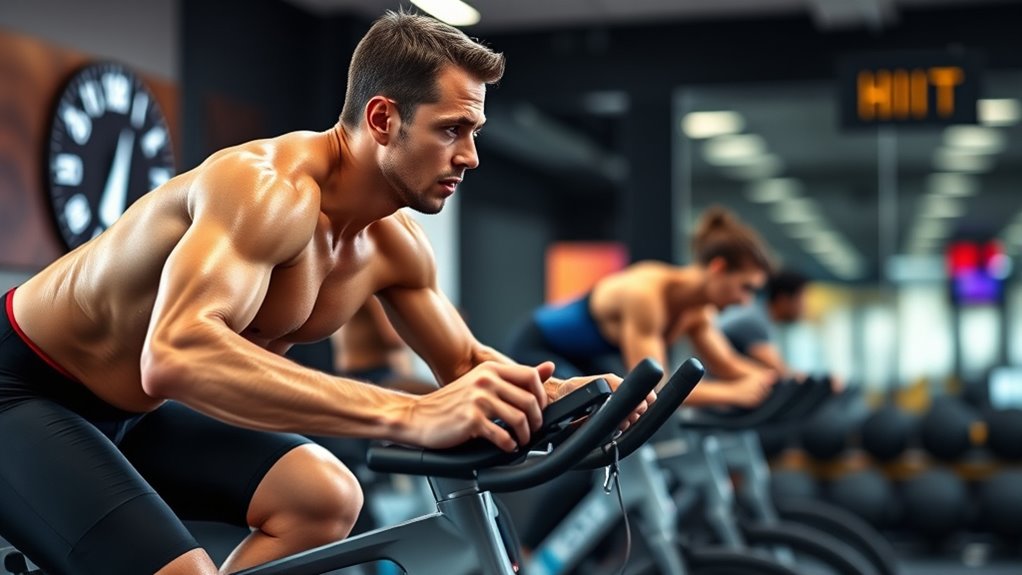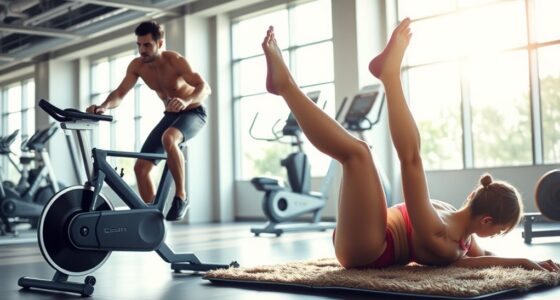If you want to burn more fat on the bike in less time, HIIT is your best bet because it boosts calorie burn during and after exercise through higher intensity efforts. Steady-state cycling burns fat steadily at moderate effort, which is better for longer endurance rides. Both methods are effective, but combining them can optimize fat loss and fitness levels. Stay with us to discover more details on how each approach works for you.
Key Takeaways
- HIIT boosts fat burning through higher intensity and post-exercise oxygen consumption (EPOC), leading to greater calorie expenditure.
- Steady-state cycling primarily uses fat as fuel at moderate intensities, promoting sustained fat oxidation over time.
- Combining HIIT and steady-state methods maximizes overall fat loss by leveraging their distinct metabolic benefits.
- HIIT results in quicker fat reduction due to intense effort and increased metabolic rate, often in less time.
- Steady-state promotes continuous fat burning during longer rides but may require more time to match HIIT’s calorie burn.
Understanding the Basics of HIIT and Steady-State Cycling

To understand the differences between HIIT and steady-state cycling, it’s important to first grasp what each training method involves. HIIT, or high-intensity interval training, alternates short bursts of maximum effort with recovery periods, boosting your cardiovascular fitness quickly. Steady-state cycling maintains a consistent, moderate intensity for a longer period, emphasizing endurance. Proper cycling nutrition supports both methods by fueling your muscles and aiding recovery, especially if you’re pushing harder during HIIT sessions. Additionally, bike maintenance is vital; a well-maintained bike ensures safety and peak performance, whether you’re sprinting or steady pedaling. Incorporating energy monitoring features in your equipment can help track your progress and optimize training intensity. Understanding how specific bike tuning modifications can enhance your workout efficiency allows you to tailor your training to your goals, guaranteeing you get the most out of each cycling session while keeping your equipment in top shape.
How the Body Burns Fat During Different Exercise Intensities

Understanding how your body burns fat during exercise depends largely on the intensity of your workout. At lower intensities, your body primarily uses fat as fuel, thanks to prime cycling biomechanics that maximize efficiency. During moderate efforts, your body shifts, blending fats and carbs for energy, making nutrition timing key to sustain performance. As intensity increases, your body relies more on carbohydrates, reserving fat burning for lower zones. Here’s how different intensities work:
| Intensity Level | Fuel Source | Cycling Biomechanics Impact |
|---|---|---|
| Low | Fat | Efficient, sustained efforts |
| Moderate | Mix of carbs & fat | Balance improves endurance |
| High | Carbohydrates | Quick energy, less fat burn |
Adjusting your effort and nutrition helps maximize fat burning during each phase. Recognizing the role of metabolic pathways can further optimize your training and fuel utilization.
The Calorie Burn Comparison Between HIIT and Steady-State Rides

When comparing calorie burns during cycling workouts, HIIT generally burns more calories in a shorter amount of time than steady-state rides. This is because HIIT maximizes calorie efficiency by pushing your body to perform at high intensities, leading to a higher calorie burn per minute. Despite shorter exercise duration, HIIT’s intense bursts boost your metabolic rate, causing you to burn calories even after the workout ends. Steady-state rides, on the other hand, burn calories steadily over a longer period but typically at a lower rate. If your goal is to maximize calorie expenditure quickly, HIIT offers a more efficient approach. Additionally, understanding the contrast ratio of your workout can influence how effectively you perceive the intensity and results. Both methods contribute to calorie burn, and your choice depends on your fitness level and time availability.
Time Efficiency: Which Method Maximizes Fat Loss in Less Time
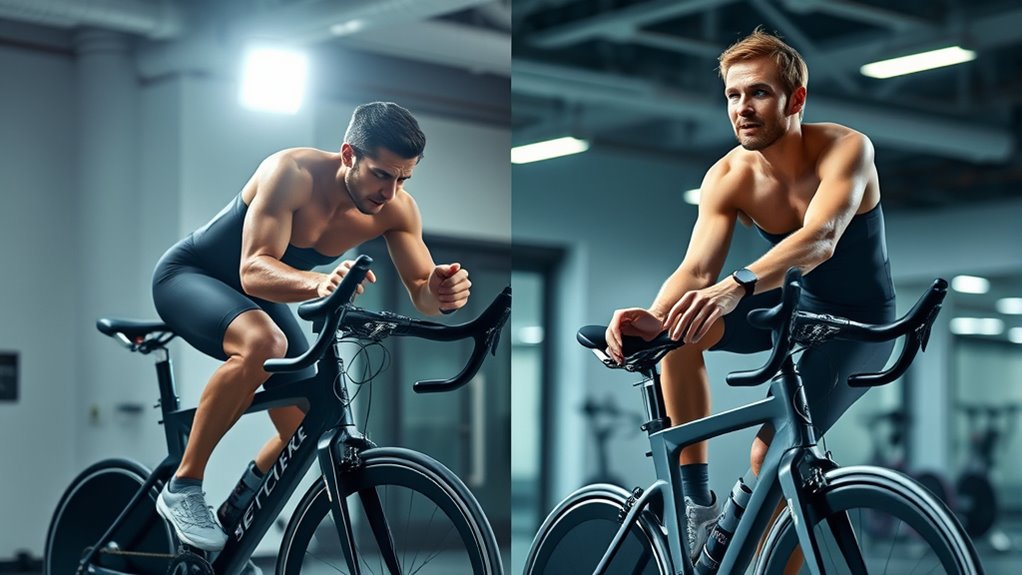
If you’re aiming to lose fat in less time, HIIT is generally more efficient than steady-state rides. Interval training allows you to maximize fat loss by pushing your body into higher intensity zones briefly, then recovering. This approach elevates your metabolic rate both during and after the workout, meaning you burn more calories in less time. Unlike steady-state rides, which require longer durations to achieve similar calorie expenditure, HIIT delivers results faster by combining short bursts of effort with recovery periods. If time is limited, HIIT’s ability to boost your metabolic rate quickly makes it the better choice for maximizing fat loss efficiently. You get more out of each workout, making your efforts more effective and time-conscious.
Impact on Metabolic Rate and Post-Exercise Fat Burning
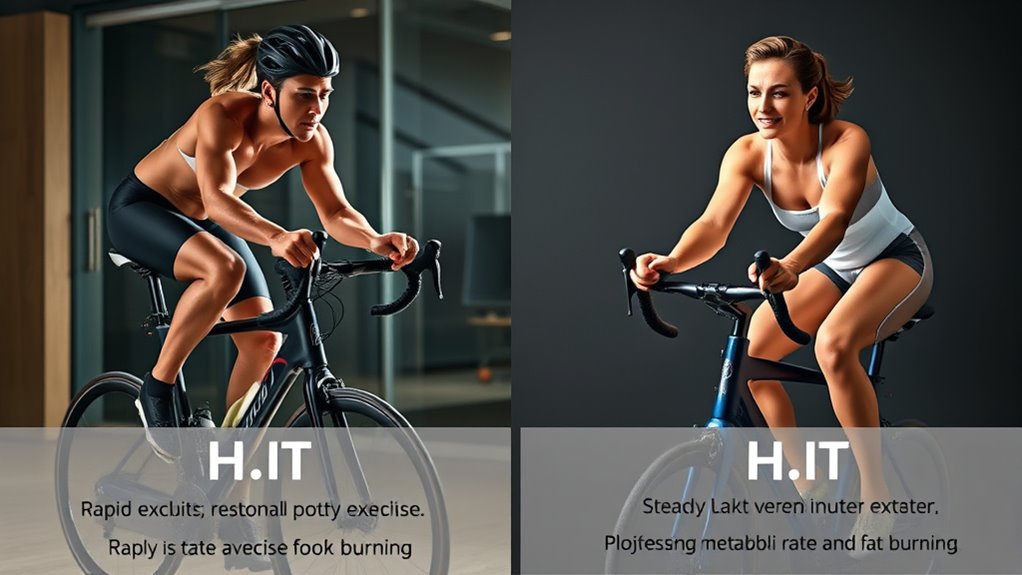
HIIT’s high-intensity bursts markedly boost your metabolic rate during the workout, leading to more calories burned in a shorter period. This form of interval training creates a significant metabolic boost that extends beyond your session. After finishing, your body continues to burn calories at an elevated rate, known as excess post-exercise oxygen consumption (EPOC). This means you keep burning fat even after you stop pedaling. Compared to steady-state cardio, HIIT’s impact on post-exercise fat burning is more pronounced, thanks to its intense nature. The rapid shifts between high and low effort push your metabolism higher and sustain that boost longer. Additionally, incorporating comfort solutions for sofa beds can improve recovery and relaxation, enhancing your overall fitness routine. Using Hyundai Tuning techniques, you can optimize your workout gear for better performance and comfort, further supporting fat loss and recovery. Proper hydration and nutritional support are also essential to maximizing calorie expenditure and fat loss. Engaging in a well-rounded routine that includes recovery strategies can help you sustain your fitness progress and prevent injury. As a result, you maximize calorie expenditure and fat loss, making HIIT a powerful tool for enhancing your overall metabolic health.
Suitability for Different Fitness Levels and Goals
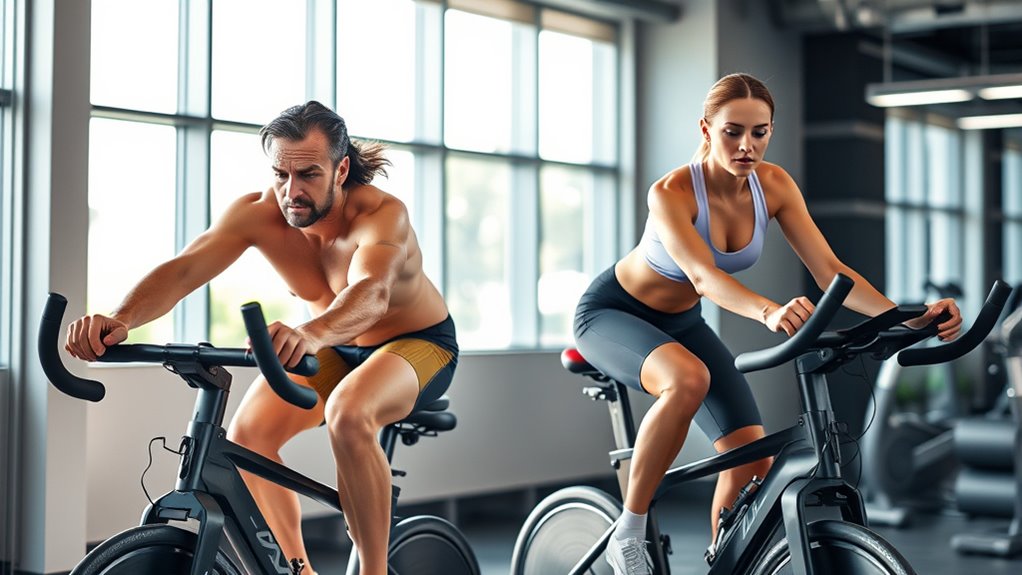
Whether you’re just starting out or are an experienced athlete, both HIIT and steady-state workouts can suit your needs. Beginners often find steady-state easier to manage, while advanced exercisers may seek the challenge of HIIT. Your fitness goals will help determine which training style fits best, whether building endurance, losing weight, or improving performance. Additionally, choosing the right environment, such as a comfortable, inviting space, can influence your motivation and consistency. Incorporating exercise intensity levels that match your current fitness can also enhance your results and prevent injury. Being aware of toilet flushing mechanisms and their efficiency can help in managing water consumption during your training or daily routines. As technology advances, Intelligent Tutoring Systems could provide personalized guidance to optimize your training approach.
Beginner-Friendly Options Available
For beginners, choosing the right workout depends on your fitness level and goals. If you’re just starting out, steady-state cycling is a great way to build endurance and confidence without overwhelming yourself. It involves maintaining a consistent pace, making it ideal for developing baseline fitness. Alternatively, interval training offers a beginner-friendly approach by alternating short bursts of higher effort with recovery periods, which can boost fitness efficiently. Incorporating simple interval sessions into your endurance cycling routine helps improve stamina gradually. Both options are adaptable; you can start with low-intensity efforts and increase intensity or duration as your fitness improves. Additionally, noise levels of modern equipment can affect your comfort during workouts, so choosing quieter gear can make your exercise sessions more enjoyable. Being aware of technological features like noise reduction can enhance your training experience. These beginner-friendly options allow you to enjoy cycling while safely progressing toward more challenging workouts in the future.
Advanced Athletes’ Challenges
While advanced athletes often seek more intense and time-efficient workouts, they face unique challenges in matching training methods to their specific goals and fitness levels. Finding the right cycling gear becomes essential, as specialized equipment can enhance performance and comfort during high-intensity sessions. Additionally, maintaining proper riding posture is critical to prevent injuries and optimize fat burn. Proper form and technique are vital to ensure effective workouts and avoid setbacks. Advanced riders often push their limits, but improper form or unsuitable gear can hinder progress or lead to setbacks. Balancing training intensity with recovery becomes more complex, and customizing workouts to align with personal goals is indispensable. Having a solid understanding of training principles ensures workouts are both safe and effective, helping athletes maximize results. These challenges require a keen understanding of one’s body and gear, ensuring that every ride is effective, safe, and tailored to reach peak performance levels. Incorporating Pimple Patches into post-ride skincare routines can help manage skin irritation caused by sweat and friction, supporting overall recovery. Additionally, paying attention to sleep and recovery can significantly impact performance and adaptation to training. Recognizing the importance of nutrition can further optimize energy levels and recovery, making it a crucial component of advanced training strategies.
Goal-Oriented Training Suitability
Choosing the right training approach depends heavily on your specific fitness level and goals. If you’re aiming to boost endurance cycling, steady state workouts are ideal, helping build sustained effort. Conversely, interval training suits those seeking quick improvements in power or fat burning. Your goals also influence suitability:
- For beginners or those focusing on general fitness, steady state cycling offers a manageable start.
- If fat loss is a priority, HIIT can maximize calorie burn in shorter sessions.
- Athletes training for endurance events benefit from long, steady rides.
- Goal-specific training allows you to tailor intensity and duration, ensuring prime progress.
Understanding these differences helps you select a program aligned with your objectives, whether it’s developing stamina, increasing strength, or burning fat efficiently.
Potential Risks and Benefits of Each Training Style
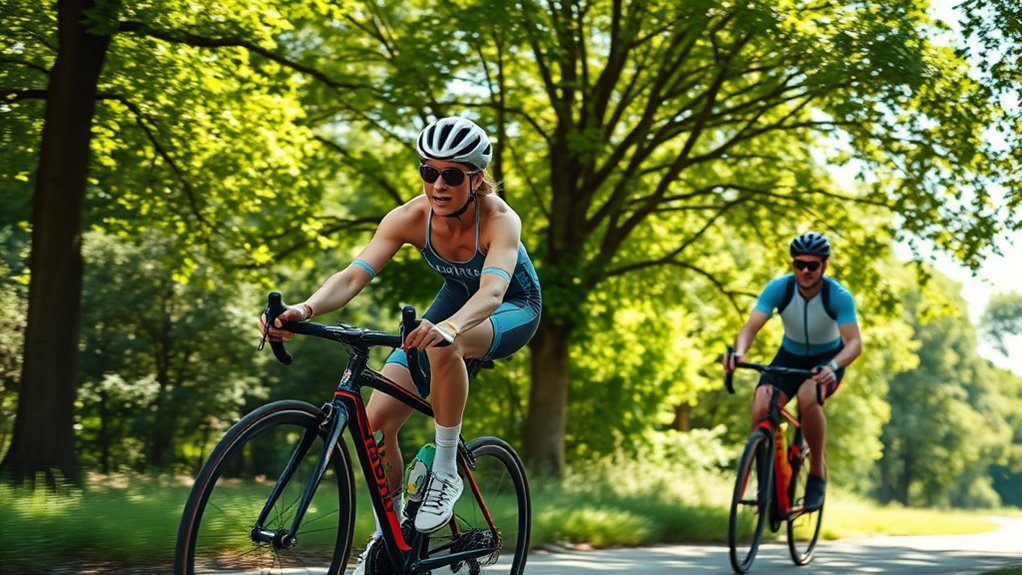
Have you ever wondered whether the risks of high-intensity interval training (HIIT) outweigh its benefits compared to steady-state cardio? HIIT offers quick fat burns and boosts cardiovascular fitness, but it can increase injury risk if you push too hard without proper injury prevention strategies. The intense effort may lead to strains or overtraining, especially if you skip adequate warm-up or ignore signs of fatigue. Equipment considerations matter too; using the right gear helps minimize injury risk and supports proper form during rapid, high-impact movements. Additionally, incorporating music therapy into your training sessions can help improve motivation and focus, potentially reducing injury risk. Proper agent programs and safety protocols are essential to ensure a secure training environment. Understanding the importance of AI security in protecting personal health data is also crucial as fitness technology becomes more integrated with AI tools. Moreover, choosing appropriate training environments can significantly influence safety and effectiveness, especially for high-intensity workouts. Steady-state cardio, on the other hand, presents a lower injury risk, making it safer for beginners or those with pre-existing conditions. While both styles have benefits, understanding these potential risks helps you choose the safest, most effective approach for your fitness goals.
Incorporating Both Approaches Into Your Cycling Routine
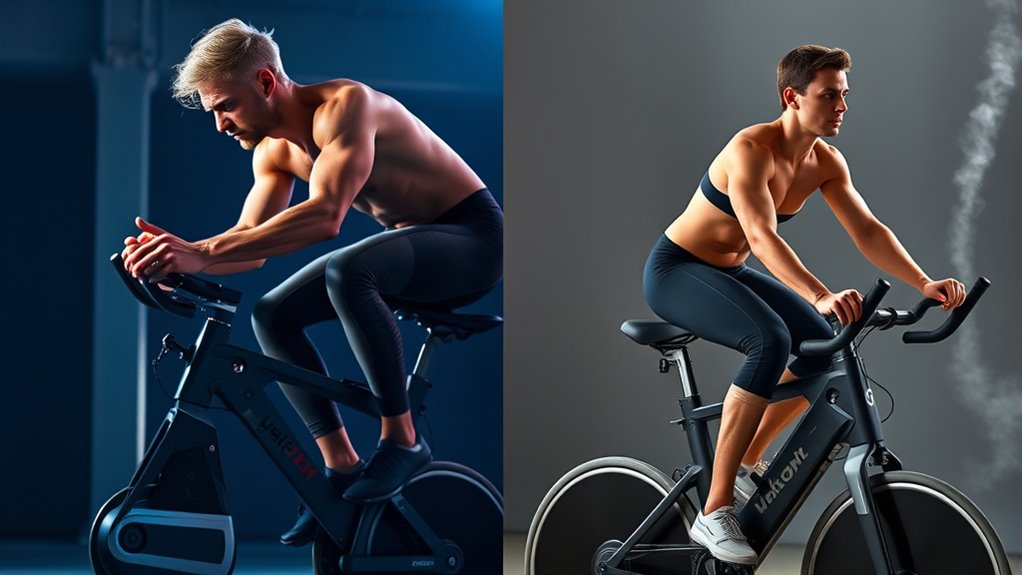
You can enhance your cycling workouts by combining both HIIT and steady-state training to suit your fitness goals and prevent boredom. To do this effectively, vary your cycling intensity and duration, ensuring proper cycling posture to avoid strain. Incorporate strategic gear selection to match the intensity levels, making shifts smoother. When mixing these approaches, consider:
- Alternating high-intensity sprints with moderate steady rides for balanced effort
- Adjusting bike gear to maintain ideal cycling posture and pedal efficiency
- Incorporating recovery periods within your routine to prevent fatigue
- Varying your route or terrain to keep workouts engaging and challenge different muscle groups
Scientific Studies Comparing Fat Loss Outcomes
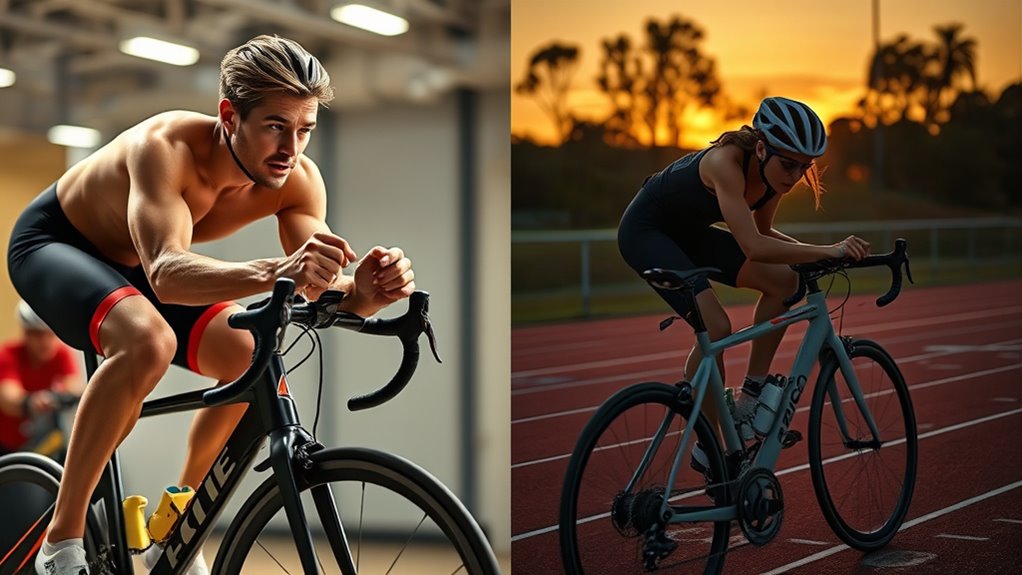
Scientific research indicates that combining HIIT and steady-state cycling can lead to different fat loss outcomes, depending on how each method is implemented. Studies show that interval training, a core component of HIIT, boosts fat burning by pushing your body into higher intensity zones, which can improve muscle endurance over time. Conversely, steady-state cycling maintains a moderate effort, promoting sustained fat oxidation. Some research suggests that while HIIT may produce quicker fat loss results, steady-state workouts contribute to longer-lasting endurance gains. Combining both approaches can optimize fat loss by leveraging the benefits of each. Ultimately, the effectiveness depends on workout design, intensity, and consistency, but scientific evidence confirms that mixing these methods influences fat loss outcomes in distinct ways.
Tips for Optimizing Fat Burn Regardless of Your Chosen Method

Regardless of whether you prefer HIIT or steady-state cycling, enhancing fat burn requires a strategic approach. First, confirm your cycling gear is comfortable and appropriate, allowing you to maintain proper form and intensity. Second, prioritize hydration strategies by drinking water before, during, and after your ride to support metabolic processes and prevent fatigue. Third, incorporate interval variations to challenge your body and boost fat oxidation. Fourth, pay attention to your nutrition—fuel your rides with balanced meals that promote fat burning without excess calories. Additionally, monitor your intensity levels to stay within the ideal fat-burning zone. By combining the right gear, staying well-hydrated, and adjusting your workout intensity, you maximize fat loss regardless of your chosen cycling method.
Frequently Asked Questions
Can Combining HIIT and Steady-State Cycling Enhance Fat Loss?
Combining HIIT and steady-state cycling boosts your fat loss through interval mixing and workout synergy. By alternating intense bursts with moderate pace, you challenge your body differently, increasing calorie burn and improving endurance. This varied approach keeps your workouts engaging and maximizes fat burning potential. Incorporating both types of training helps you break through plateaus, making your fitness routine more effective and efficient in achieving your weight loss goals.
How Does Diet Influence Fat Burning During HIIT Versus Steady-State Rides?
Think your workout alone burns all the fat? Think again. When you’re doing HIIT or steady-state rides, your diet’s influence is the real secret weapon. Proper nutrition timing and balanced macronutrient ratios fuel your body efficiently, boosting fat burning. Skimp on carbs or protein, and even your hardest efforts might fall flat. So, you hold the key—what you eat before and after rides determines how much fat you truly shed.
What Are the Long-Term Effects of Each Training Style on Metabolism?
You’ll experience different long-term effects on metabolism depending on your training style. With HIIT, you get greater metabolic adaptation and a strong hormonal response, boosting your calorie burn even after workouts. Steady-state rides promote steady fat burning and improved endurance but may lead to less metabolic change over time. Consistently switching between both can optimize your metabolic health and keep your workouts effective and engaging.
Are There Specific Signs That Indicate Which Method Is More Effective for Me?
You might notice signs indicating which method works best for you by monitoring your heart rate variability and perceived exertion. If your heart rate fluctuates and you feel a push-and-pull during workouts, HIIT could suit you. Conversely, if your perceived exertion remains steady and your heart rate stays within a consistent range, steady state might be more effective. Trust your body’s signals to determine which style aligns with your fitness goals.
How Do Environmental Factors Impact Fat Burning During Cycling Workouts?
Think of environmental factors like wind resistance and air quality as the wind pushing against you on a bike ride. Poor air quality can make your body work harder to breathe, reducing fat-burning efficiency. Wind resistance, especially on windy days, increases your effort, boosting calorie burn but also tiring you out faster. To optimize fat burning, ride in calm conditions with good air quality whenever possible, adjusting your effort accordingly.
Conclusion
Whether you choose HIIT or steady-state cycling, focus on consistency, challenge, and proper recovery. Push your limits, listen to your body, and stay committed to your goals. Embrace variety, track your progress, and refine your approach. Remember, the key to burning more fat lies in effort, endurance, and enjoyment. Keep moving, stay motivated, and let your dedication turn your rides into powerful fat-burning sessions.
